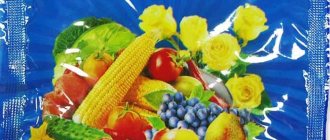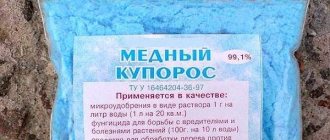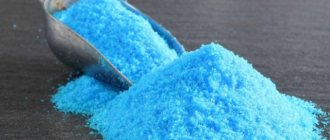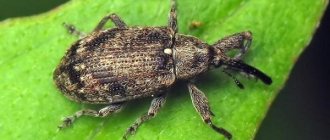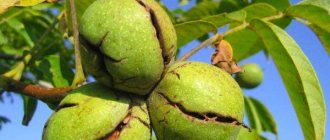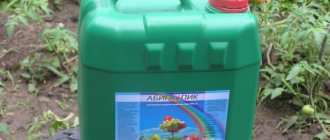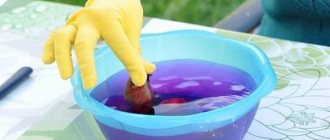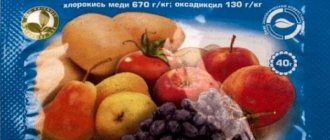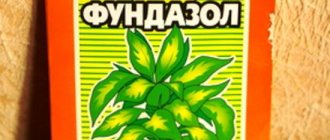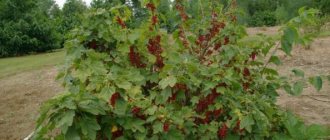What is iron sulfate?
It is also called ferrous sulfate or ferrous sulfate. Vitriol is greenish crystals, opaque, odorless. If you taste them, you will find that it is metallic and highly astringent. Ferric sulfate is hygroscopic and highly soluble in warm water. The product produced by industry for use in horticulture contains at least 54% FeSO4.
At what temperature can it be used?
You will be interested to know: Fighting spider mites on flowers: the best folk remedies and preparations
A solution of iron sulfate is ideally suited for eradicating autumn treatment of shrubs and trees in the garden, since it can be sprayed at temperatures below +5 degrees. The main thing is that the air temperature does not fall below 0 degrees.
Wait for the leaves to fall and treat the garden along the bare branches. That is, you need to spray the garden on bare branches in the fall.
Advice! You can also treat garden shrubs and trees with other preparations (fungicides, insecticides) in the fall. Be sure to read the instructions, which tell you at what temperature they can be used. Many products only work at temperatures above +5 degrees.
Purpose of iron sulfate
The substance has antiseptic and fungicidal properties, so iron sulfate is used in gardening for spraying and whitewashing trees from fungus, mosses and lichens growing on the trunk and branches, and treating wounds on the bark.
They treat grapes and berry bushes, trees against pests, and use them as a microfertilizer containing iron for the prevention and treatment of chlorosis.
In addition to using iron sulfate in gardens and vegetable gardens, it is also used to treat premises and wooden structures against mold or fungi.
Preparation for processing
It is worth noting that before the actual action of protecting the garden with special means, careful preparation is necessary. First of all, it is important to prepare materials and tools:
- Sprayer - gasoline models have high power, which makes it possible to cover a large area in one day. In addition, gasoline units can be refueled anywhere, but they are heavier and larger than battery-powered ones. Battery-powered models have the lowest noise level during operation, but their performance is less than that of gasoline models.
- Protective respirator or gauze bandage.
- Latex gloves.
- Preparations for spraying (selected in any specific case).
- Protective glasses.
Popular: Five ways to preserve any variety of cabbage in winter
It is necessary to carefully examine the components of trees (branches and trunks) for the presence of lichens and moss. If found, remove it with a wire brush. You need to inspect the device you will use to spray.
Treat trees completely, as a partial procedure may not give the expected result and harm the plant. Consider the consistency of the solution - it should be extremely homogeneous. Before pouring the solution into the device, mix it thoroughly with water. If this rule is not followed, there is the possibility of heterogeneity, which will lead to uneven processing - some trees are sprayed with plain water, and some will be exposed to the influence of an undiluted substance.
Spraying trees in autumn
Garden treatment is aimed at removing diseases and parasites. Insects hide under the bark, in the soil, on branches. As a result of disinfecting the garden in the fall, you can get a positive effect:
- the moss will fall away from the bark;
- plants receive a dose of iron - prevention of chlorosis;
- growth and development of plants will increase.
It is better to spray the garden twice with a break of a week. When working with chemicals, you need to protect yourself from harmful influences.
How to dilute the drug correctly
To obtain the solution, you can only use plastic or ceramic containers, but not metal. There should be no traces of any substances on its walls. To properly dilute iron sulfate, first pour it into warm water and mix. Then, after 20 minutes, when it has infused, stir again.
The concentration will depend on the purpose of use. It is convenient to measure the amount with a matchbox, a tablespoon or a teaspoon. A matchbox contains 22 g of the substance, 16 grams in a tablespoon, 5 g in a teaspoon.
For treatments, prepare a 5 and 3 percent solution (take 500 g and 300 g per 10 l, respectively).
Precautionary measures
Every gardener or gardener, when working with iron sulfate, must follow safety rules so as not to cause harm to himself. When preparing the solution and treating plants, you need to wear special gloves and a respirator.
Important! Vitriol is not a toxic substance, but it is better to protect the skin and respiratory tract from contact with the fungicide.
If drops of the substance get on the skin or eyes, you should immediately rinse these areas with water.
Experienced gardeners and gardeners assure that the timely use of iron sulfate in compliance with all the rules is of great help in growing a healthy and strong plant that produces a high-quality harvest.
Watch the video! Inkstone. autumn processing. what is it for?
Instructions for use
The instructions for using iron sulfate, located in the package, always indicate in what proportion to dilute it and why, as well as the consumption rate.
Against pests
Iron sulfate is used to poison some tree pests that hide under the bark in winter. To do this, in the spring, when the buds have not yet begun to bloom, the trees are sprayed or doused with a solution of the substance on their trunks and branches. Getting under the bark, it destroys insects, sleeping larvae, and eggs. A liquid that can cope with pests should be 5% (500 g per 10 l). The same can be done in the fall, when the entire harvest has been harvested.
The treatment of apple trees and other trees with iron sulfate should not be carried out on blossoming buds and leaves, the drug will cause burns.
Fighting mosses and lichens
On trees of the stone fruit and pome family, and fruit bushes, iron sulfate is used to destroy mosses and lichens that damage the bark. To treat the garden with iron sulfate, the time is chosen early in the spring, before the buds begin to bloom. Spray the plants themselves and the soil around them.
For trees, re-treatment of lichens is carried out after another 2 weeks, the bushes are sprayed again in the fall. Trees are treated with a 5% solution, that is, 500 g of the substance is dissolved in 10 liters. If you add ash extract to iron sulfate (take 1 tbsp of ash, pour 3 liters of boiling water and leave for 3 days), you will get a mixture that can be used to whiten tree trunks.
Iron sulfate is also used to remove moss from the lawn. It can grow in acidic soils and shaded areas. Such plots are treated with a 5% solution with the addition of 1% Bordeaux mixture. The best time to treat your lawn is a dry, cool day.
Treatment of fungal diseases
Scab, powdery mildew, black cancer, rot, clasterosporiosis, and septosporiasis can be treated with iron sulfate. For these diseases, trees are sprayed with a 3% (stone) or 5% (poma) solution.
Treating strawberries with this substance will help against gray rot, spotting, powdery mildew, rot and late blight. A 3% liquid is suitable for this. Bushes are sprayed with it during preparation for winter - after the leaves are removed from them in the fall. Treatment of roses with iron sulfate is also carried out in the fall, in the process of preparing them for wintering. A 3% solution is watered on the shoots, and 5% on the soil around the bushes.
Treatment against chlorosis
When there is a lack of iron in the soil, plants suffer from chlorosis. Their leaves lighten and turn yellow, but the veins remain green. From iron sulfate at home, you can prepare iron chelate - a valuable microfertilizer used for the prevention and treatment of this phenomenon. In chelated form, iron is most accessible to plants. Fertilizer can be watered or sprinkled on the leaves of the plants.
How to cook: add 1 tsp of citric acid to 3 liters, add 1 tbsp. l. iron sulfate. The mixture must be used within 1-2 hours after preparation, otherwise it will lose its properties.
Spraying the grapevine
Grapes can be treated with iron sulfate against mildew, bacterial cancer, anthracnose, and spotty necrosis. Prepare a 3-5% solution. They are also sprayed against pests. In addition to a protective agent, iron sulfate can be a fertilizer that is applied at the root or along the leaf. The deficiency of this element can be determined by poor growth of shoots, small size of young foliage, its light green color, thin shoots, and delayed harvest ripening. This indicates that the plant urgently needs iron feeding. Root application is combined with watering, the solution is made from 15 g per 10 liters. For foliar feeding with iron sulfate for grapes, dilute 5-10 g per 10 liters.
The substance is also used to delay the opening of grape buds in the spring if frosts are expected. After removing the cover, the vine is sprayed with 0.5-1% liquid. This slows down the opening of the buds for approximately 2 weeks. The use of iron sulfate in gardening in the fall is also true for grapes. Immediately after the leaves fall, the plant itself and the ground around it are sprayed with a 3-5% solution to destroy pathogens and various pests.
Treatment of grapes in the spring is also carried out during rooting of cuttings. They are left in 0.5% soaking liquid. This slows down the development of buds and accelerates the growth of roots. Such material takes root and takes root faster and better. This treatment of grapes with iron sulfate also prevents infection of cuttings and the development of fungi, lichens, and phylloxera.
Spraying berry bushes and trees
For currants, a 3 or 1% solution is suitable. Treatment time: early spring, before sap flow, and autumn, after complete fall of leaves, pruning of excess and damaged shoots, and removal of plant litter. Raspberries are treated with iron sulfate in the same way.
Treatment of cuts and wounds on tree branches
Cracks in the bark are moistened with a 1% solution for disinfection. To enhance the effect, it is recommended to alternate iron sulfate with copper. Wounds and hollows, especially if signs of the disease are clearly visible in them, are disinfected with 10% liquid. The instrument is also washed in this liquid after each plant.
Application as fertilizer
Iron sulfate is a fertilizer; plants receive the element from it in a highly digestible form and in the required quantity.
Foliar treatment
Requires 0.05% liquid (dissolve 5 g per 10 l). Spraying with iron sulfate is done once a week until signs of chlorosis disappear.
Root feeding
For watering garden plants, prepare a 0.1% solution, water first with just water, then with iron sulfate.
Advantages and disadvantages of the product
Fungicides of chemical and organic origin can have different effects on the development of different crops. Therefore, you will need to follow certain rules when using ferrous sulfate.
Attention!
Applying the product in spring or autumn does not matter.
If the drug is used in the garden for a long time, it therefore has a number of positive qualities. These include:
- slowing down bud break, thanks to which the crop is protected from return frosts;
- saturation of soil with iron;
- effectiveness, so it can save the plant from many diseases;
- the ability to process shoots and even soil;
- low level of toxicity;
- wide scope of application;
- use mono as fertilizer;
- availability;
- long shelf life if properly stored;
- treatment of wounds and filling cavities in trees. To do this, dilute 1 kg of the substance in 10 liters of water.
But there are also shortcomings:
- the positive effect does not last long - iron sulfate will lose its beneficial properties in 1.5-2 weeks;
- It is necessary to apply the product in the spring only until the first buds appear, otherwise a chemical burn will occur;
- the drug is effective against fungus, but does not destroy bacteria;
- rain will quickly wash the drug off the leaves and branches;
- to eliminate parasites, you need to additionally resort to the help of auxiliary means;
- can be processed in spring or autumn, before foliage appears;
- the temperature for working with the drug must be positive;
- after the leaves appear, only a 1% solution can be used, which is not effective for the fungus.
When using iron sulfate, these factors must be taken into account.

